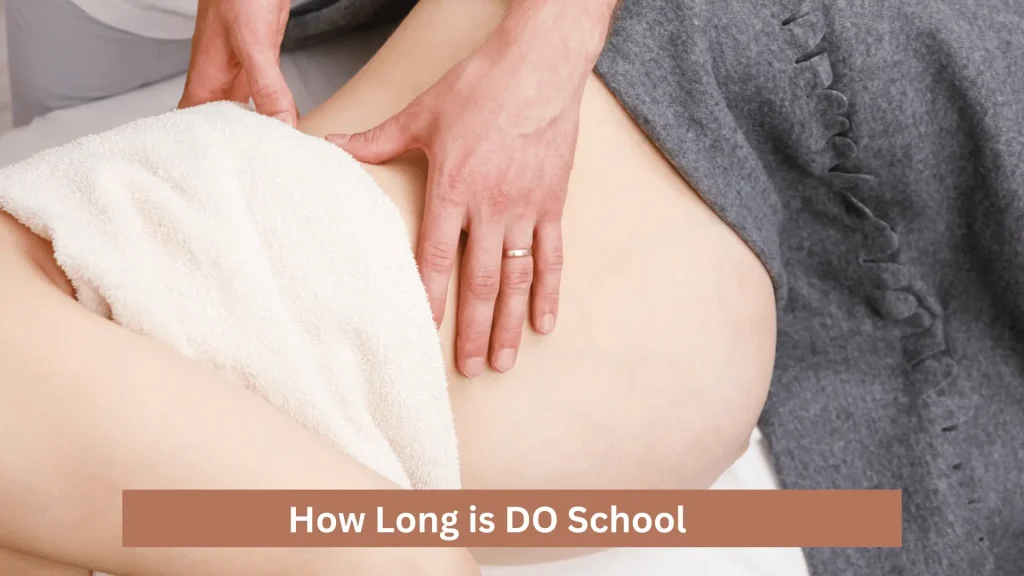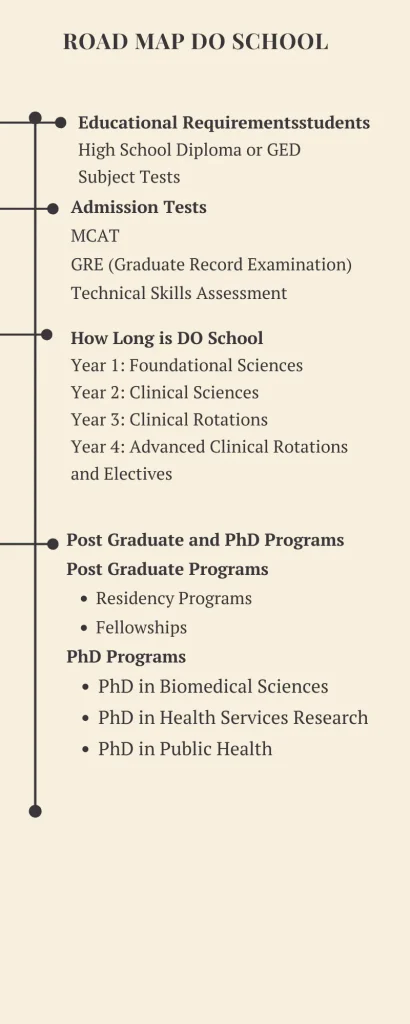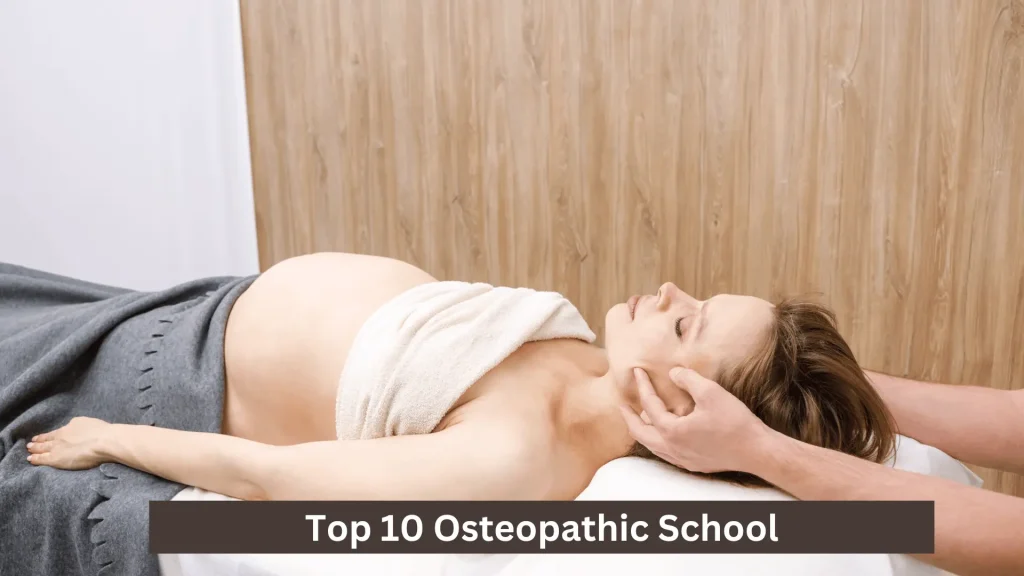How Long is DO School
How Long is DO School? A Doctor of Osteopathic Medicine (DO) program typically lasts four years. This includes two years of classroom-based learning followed by two years of clinical rotations. Afterward, graduates often complete a residency, which can range from three to seven years depending on the specialty.
What is DO School
DO school, short for Doctor of Osteopathic Medicine school, trains physicians with a holistic approach to medicine. DOs emphasize the body’s ability to heal itself and focus on preventive care, integrating traditional medical practices with osteopathic manipulative treatment (OMT). Students learn to diagnose and treat illnesses while considering lifestyle and environmental factors that may impact health.

In addition to standard medical training, DO schools incorporate OMT, which involves hands-on techniques to diagnose and treat conditions. This approach allows DOs to offer more personalized care by considering the patient’s entire body system. Graduates from DO schools are fully licensed physicians who can specialize in various medical fields, similar to their MD counterparts.
How Long is DO School
Year 1: Foundational Sciences
Fall Semester:
- Anatomy: Comprehensive study of human anatomy, including lab work with cadavers.
- Histology: Study of tissues and cells under the microscope.
- Biochemistry: Understanding the chemical processes within and related to living organisms.
- Physiology: Functions and mechanisms in the human body.
- Osteopathic Principles and Practice (OPP) I: Introduction to osteopathic manipulative treatment (OMT) techniques.
- Medical Ethics: Ethical considerations in medical practice.
Spring Semester:
- Neuroanatomy: Structure and function of the nervous system.
- Microbiology and Immunology: Study of microorganisms and the immune system.
- Pathology: Study of disease mechanisms and effects on the body.
- Pharmacology I: Basics of drug action and therapeutic uses.
- OPP II: Continued training in osteopathic manipulative techniques.
- Clinical Skills I: Introduction to patient interaction and basic clinical skills.
Year 2: Clinical Sciences
Fall Semester:
- Pathophysiology I: Understanding disease processes and their effects on the body.
- Pharmacology II: Advanced concepts in drug therapy.
- Clinical Medicine I: Integration of clinical sciences with patient care.
- OPP III: Advanced osteopathic manipulative techniques.
- Clinical Skills II: Advanced clinical skills and patient interaction.
Spring Semester:
- Pathophysiology II: Continued study of disease processes.
- Behavioral Medicine: Psychological aspects of patient care.
- Clinical Medicine II: Continued integration of clinical sciences.
- OPP IV: Further advanced OMT techniques.
- Clinical Skills III: Preparation for clinical rotations, including advanced diagnostic skills.
Year 3: Clinical Rotations
Core Rotations:
- Internal Medicine: Diagnosis and treatment of adult diseases.
- Surgery: Principles and practices of surgery, including hands-on experience.
- Pediatrics: Healthcare of infants, children, and adolescents.
- Obstetrics and Gynecology: Women’s health, pregnancy, and childbirth.
- Family Medicine: Comprehensive care for individuals and families across all ages, genders, diseases, and parts of the body.
- Psychiatry: Mental health and psychiatric disorders.
- Emergency Medicine: Acute care and management of emergency situations.
- Osteopathic Manipulative Medicine (OMM): Application of OMT in clinical settings.
Year 4: Advanced Clinical Rotations and Electives
Advanced Rotations:
- Sub-Internships: In-depth rotations in areas such as internal medicine, surgery, pediatrics, etc.
- Specialty Electives: Focused rotations in specialties of interest, such as cardiology, neurology, orthopedics, etc.
- Rural or Underserved Medicine: Rotations in rural or underserved areas to provide care to diverse populations.
Additional Requirements:
- Research Projects: Involvement in clinical or biomedical research.
- Board Exam Preparation: Intensive preparation for COMLEX-USA (Comprehensive Osteopathic Medical Licensing Examination).
- Clinical Skills Exams: Practical exams to assess clinical and diagnostic skills.

How to Enter DO School
Educational Requirements
Bachelor’s Degree: A bachelor’s degree from an accredited institution, typically with a focus on pre-medical courses.
Prerequisite Courses: Courses usually include biology, chemistry (general and organic), physics, and often biochemistry and math.
GPA: Competitive applicants generally have a GPA of 3.5 or higher, though this can vary by school.
Entry Tests
MCAT: Medical College Admission Test (MCAT) scores are required. A competitive score is generally above 500, though this can vary by program.
Letters of Recommendation: Typically required from professors, and healthcare professionals, often including one from a DO.
Application Process
AACOMAS: Primary application is submitted through the American Association of Colleges of Osteopathic Medicine Application Service (AACOMAS).
Personal Statement: An essay detailing your motivation for pursuing osteopathic medicine.
Secondary Applications: Additional applications specific to each DO school, often requiring more essays and application fees.
Interviews: Selected applicants are invited for interviews, which may include multiple mini-interviews (MMI) or traditional panel interviews.
Financial Aids
Federal Loans: Stafford Loans and Grad PLUS Loans are available for medical students.
Scholarships: Various merit-based and need-based scholarships offered by individual DO schools, national organizations, and private foundations.
Loan Repayment Programs: Programs such as the National Health Service Corps (NHSC) provide loan repayment for services in underserved areas.
Work-Study: Opportunities for part-time employment on campus to help offset expenses.
Military Scholarships: Programs like the Health Professions Scholarship Program (HPSP) cover tuition and provide a stipend in exchange for military service.
Post Graduate and PhD Programs
Postgraduate Programs for DO Graduates
Residency Programs:
Duration: 3 to 7 years, depending on the specialty.
Types: Includes specialties such as family medicine, internal medicine, surgery, pediatrics, obstetrics and gynecology, psychiatry, and more.
Requirements: Completion of a DO program, passing board exams, and a successful match through the National Resident Matching Program (NRMP) or other matching services.
Fellowships:
Duration: 1 to 3 years, following residency.
Types: Advanced training in subspecialties like cardiology, oncology, endocrinology, or sports medicine.
Requirements: Completion of residency in the chosen field and acceptance into a fellowship program.
PhD Programs for DO Graduates
PhD in Biomedical Sciences:
Focus: Research in fields such as molecular biology, pharmacology, or genetics.
Duration: Typically 4 to 6 years, including coursework, research, and dissertation.
Requirements: Prior research experience is beneficial; some programs may require a strong academic background in science.
PhD in Health Services Research:
Focus: Study of healthcare systems, policy, and outcomes.
Duration: Typically 4 to 5 years, including coursework, research, and dissertation.
Requirements: Interest in healthcare delivery and policy analysis, with a background in health sciences or related fields.
PhD in Public Health:
Focus: Public health research, epidemiology, biostatistics, or health education.
Duration: Generally 4 to 6 years.
Requirements: A background in public health or a related field, and research experience is often beneficial.
Financial Aid for Postgraduate and PhD Programs
Fellowships and Grants:
For PhD Programs: Research-based fellowships, teaching assistantships, and grants from institutions or government agencies.
For Residency Programs: Generally funded by the residency program; salaries and benefits are provided.
Student Loans:
For PhD Programs: Federal and private student loans are available.
For Residencies: Residencies typically provide a salary, but additional loans may be used for living expenses.
Scholarships and Awards:
For PhD Programs: Merit-based or need-based scholarships and awards from academic institutions or professional organizations.
For Residencies: Some specialized awards or grants may be available based on research or academic achievements.
Top 10 Osteopathic Medicine Schools

1.Philadelphia College of Osteopathic Medicine (PCOM)
Location: Philadelphia, Pennsylvania
Notable for its comprehensive medical education and strong clinical training.
2.Des Moines University (DMU)
Location: Des Moines, Iowa
Renowned for its emphasis on primary care and osteopathic principles.
3.Michigan State University College of Osteopathic Medicine (MSUCOM)
Location: East Lansing, Michigan
Notable for its research facilities and strong focus on community-based medicine.
4.Touro University California
Location: Vallejo, California
Known for its innovative curriculum and commitment to serving underserved populations.
5.Nova Southeastern University Dr. Kiran C. Patel College of Osteopathic Medicine (NSU-KPCOM)
Location: Fort Lauderdale, Florida
Offers a diverse curriculum with a strong focus on research and community service.
6.Lake Erie College of Osteopathic Medicine (LECOM)
Locations: Erie, Pennsylvania; Bradenton, Florida; Greensburg, Pennsylvania
Recognized for its early clinical exposure and unique educational pathways.
7.A.T. Still University School of Osteopathic Medicine in Arizona (ATSU-SOMA)
Location: Mesa, Arizona
Known for its patient-centered curriculum and strong emphasis on primary care.
8.Kansas City University College of Osteopathic Medicine (KCU-COM)
Location: Kansas City, Missouri
Offers a robust clinical training program and extensive research opportunities.
9.Oklahoma State University Center for Health Sciences College of Osteopathic Medicine (OSU-COM)
Location: Tulsa, Oklahoma
Noted for its focus on primary care and rural medicine.
10.University of New England College of Osteopathic Medicine (UNE COM)
Location: Biddeford, Maine
Recognized for its commitment to primary care and its innovative educational approaches.
These schools are well-regarded for their academic rigor, clinical training, and overall contributions to the field of osteopathic medicine.
Factors Affecting the Length of DO School
1. Program Structure
Curriculum Design: Some DO programs may have slightly different curricular structures, such as integrated or systems-based learning, which could impact the overall pace and organization of the program.
Accelerated Programs: Some institutions offer accelerated or dual-degree programs that might shorten the overall time spent in medical school.
2. Clinical Rotations
Timing and Duration: The scheduling and length of clinical rotations can affect how students experience their training. Some programs offer longitudinal clinical experiences, which might overlap with classroom learning.
Electives: The availability and choice of elective rotations can also influence the experience, though not typically the length.
3. Personal Factors
Pace of Learning: Individual learning speeds and study habits can impact how efficiently a student progresses through the coursework and clinical training.
Health and Personal Issues: Personal health or life circumstances may necessitate additional time to complete the program.
4. Residency and Fellowships
Post-Graduate Training: While the DO school itself is four years, the length of training extends into residency and fellowship programs, which can range from 3 to 7 years or more, depending on the specialty.
5. Institutional Policies
Program Requirements: Different schools may have unique graduation requirements or additional certifications that can affect the timeline.
Academic Performance: Students who need to retake courses or complete additional requirements may experience delays.
Final Verdict
The length of DO school typically spans four years, but various factors such as program structure, personal circumstances, and institutional policies can influence the experience and timeline. Understanding these factors can help prospective students better prepare for their medical education journey.
FAQs
1.What is the duration of DO school?
DO school generally lasts four years, including classroom learning and clinical rotations.
2.Are there accelerated DO programs?
Yes, some institutions offer accelerated or dual-degree programs that may shorten the duration.
3.How does clinical rotation timing affect DO school?
The scheduling of clinical rotations can impact how students experience their training, but not the overall length.
4.Can personal factors affect the length of DO school?
Yes, individual learning pace, health issues, or life circumstances might extend the time required to complete the program.
5.What additional training follows DO school?
Post-graduate residency and fellowship programs follow DO school, extending the total duration of medical training.
